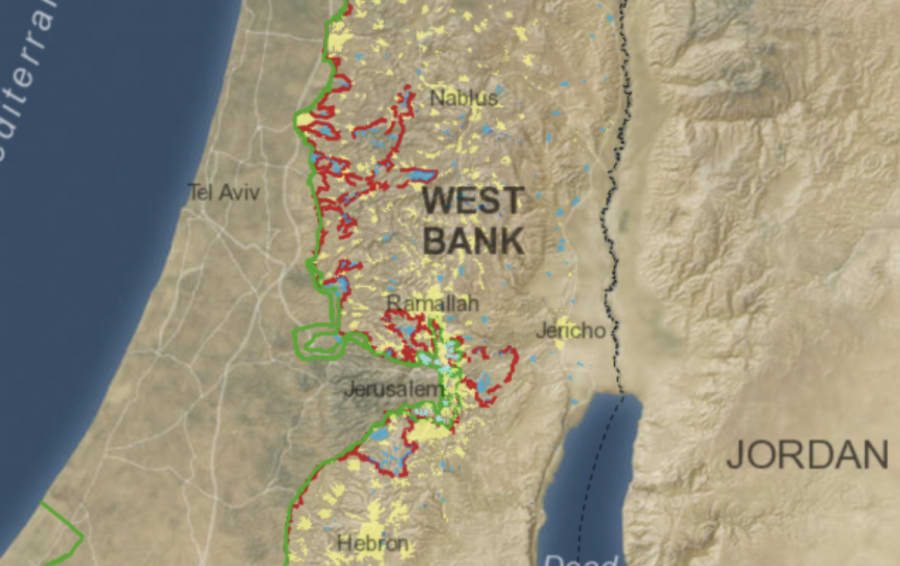What is the ‘Green Line’ in Israel?
Author provides the history of the border between Israel and the West Bank and why the two-state solution remains elusive

The “Green Line” is the name given to the border between Israel and the West Bank.
In 1949, the Green Line was considered the de facto border of the State of Israel and was named for the green ink that was used to draw the physical boundary line.
But let’s go further back, to the beginning.
Under the Ottoman Empire, none of these borders existed and Arabs and Jews moved freely between Cairo, Jerusalem, Beirut, Damascus and Constantinople without too much trouble.
Following WWI, the empire crumbled and fell, and the European war victors carved up the Middle East, the event responsible for almost all borders we know today.
However, the Green Line was not one of them.
The predecessor of the United Nations, the League of Nations, granted the areas today known as Syria and Lebanon to France, and the areas today known as Iraq, Jordan, and Israel to Great Britain. These were known as mandates, not colonies, with the idea that these European empires would control the areas until they could become independent.
At that time, the border between Israel and the West Bank didn’t exist. The entire area known today as Israel and the Kingdom of Jordan were together called “The Mandate of Palestine, based on the agreement signed at the San Remo conference in 1920. The agreement also included the British obligation to incorporate the Balfour Declaration, issued by Great Britain in 1917. The Zionist movement saw this as a legal obligation to establish a Jewish homeland within that entire territory.
In 1921, however, the British established Transjordan as a protectorate under their rule and put Abdullah bin Hussein of the Royal Hashemite family in charge. They did the same in Iraq, putting his brother, Faisal, in charge. This would eventually lead to Iraq’s and Transjordan’s independence, decades later.
This move infuriated many Zionist Jews who were living in Israel, as two-thirds of their country was taken away from them. Jabotinsky’s ideological organization, Beitar, had an anthem saying, “The Jordan River has two banks: One side is ours, and so is the other.”
When Beitar’s armed branch, the Irgun, was established in 1937, they had a symbol with area of Israel and Jordan together as one, with the slogan “Only Thus.” These organizations were in opposition to then Prime Minister David Ben-Gurion and the mainstream socialist Jewish leadership who took a more pragmatic approach, often cooperating with the British.
Well, if the Brits ripped Transjordan away, then this one little third, this tiny sliver of land between the Jordan River and the Sea, at least the Jews would get all of that on the basis of the legal requirements of the San Remo conference and the Balfour Declaration, right? Right?
Nope. Even this little piece, the British leaders wanted to divide into two – one Arab and one Jewish nation. A number of propositions came up throughout the 1930s, especially after the full-scale Arab riots of 1929, and the violent Arab revolt of 1936.
Some of these proposals were rejected, while some were accepted by the Jewish leadership, who were desperate to get any little piece of land so they could offer a place of refuge for the Jews of Europe living under a looming Nazi threat. But the propositions were all rejected by the Arab leadership, who insisted on all or nothing, which is why they got nothing.
World War II put everything on hold, and once it was over, there was an ever greater need for a Jewish homeland due to the multitudes of Jewish refugees throughout Europe. Great Britain turned the decision over to the newly-established United Nations.
The UN eventually proposed the well-known 1947 plan that was voted upon and passed on Nov. 29, 1947. The Jews accepted it, desperate to have any little piece of land, so they could offer a place of refuge to the holocaust survivors of Europe. But the proposition was rejected by the Arab leadership, who insisted on all or nothing, which is why they, again, got nothing.
As soon as the resolution passed, the War of Independence began with attacks and bloodshed between Arabs and Jews. British troops knew they would leave in May 1948 and showed no interest in keeping order or in implementing the UN decision. The borders of the proposed Israel and Palestine that the UN had presented were not enforced in any way. The British preferred to just leave it as it is and let the Jews and Arabs fight it out.
Which they did.
As soon as they left, Israel declared independence on May 14, 1948, without specifying what the borders of this new state would be.
The regular armies of five surrounding countries attacked Israel simultaneously. There was never a question of whether the 1947 borders would ever come into being because the Arabs demanded all or nothing. And they got nothing, again.
In 1949, Israel agreed to a cease-fire, negotiated in Rhodes, where the border today known as the Green Line was drawn up for the first time, as the temporary border between Israel and Transjordan.
Transjordan now ruled both sides of the river and changed its name to the Kingdom of Jordan. Jabotinsky’s successor, Menachem Begin, was furious. Israel was giving up East Jerusalem, the Western Wall, Hebron, Shilo, Shechem and all the important places of the Bible. Jordan physically expelled hundreds of Jews who had lived there for centuries.
The State of Israel finally existed, but it was not equivalent to the biblical Land of Israel.
Jordan insisted that the cease-fire clearly state that these borders were not final and not internationally- recognized borders. They were temporary cease-fire lines put in place until a final agreement could be reached. So far the temporary status has lasted for some 74 years, longer than the entire existence of communist Soviets.
The idea of an independent Palestine was never even up for discussion. The Jordanians took the West Bank and Egypt took the Gaza Strip. The temporary Palestine government that some Palestinian nationalists set up in Gaza was dissolved by the Egyptians pretty quickly.
People are divided on whether it was Egypt or Israel who started the Six-Day War in 1967, as it was evident that Egypt built up for a major conflict and Israel shot the first bullet with a pre-emptive strike.
Jordan’s role, however, is not debated. It’s very clear. They attacked first.
Israel was already in a war on two fronts against Egypt and Syria, and the last thing they wanted was another front. They made it very clear to Jordan, through international channels, that if they stay out of the war, Israel will not attack them. But they didn’t listen.
When Jordan attacked, Israel conquered the West Bank in just a few days, and this is also where we must ask the question: Do we wish to live in a world where an aggressor doesn’t take a risk? Do we wish to live in a world where someone can attack another country and not risk losing a part of their own land?
As soon as the Israeli military conquered the West Bank, many voices in Israeli society claimed that it was time to go back and reestablish the Jewish communities that had been laid to waste in 1948. And set up a few more. The government said no. They wished to use the West Bank as a negotiation card to pressure the neighbors into signing peace agreements. They redrew some of the borders of the Green Line and annexed East Jerusalem because a divided city is never a good idea, especially not a capital. But everything else was kept as “occupied territory” under international law, even though many Jews, especially Menachem Begin, loudly protested this. The Green Line was never erased.
Israel’s hopes for peace agreements were ruined when the Arab nations expressed the Khartoum Resolution in September 1967, effectively saying no to any agreement or negotiation with Israel. Still, Israel refused to give up hope and didn’t allow any Jewish settlements in the West Bank whatsoever.
East Jerusalem, however, was a different issue. Jewish neighborhoods were built in the newly- conquered areas almost right away. But the rest of the West Bank? No Israelis. Just Israeli military rule and the local Palestinian population until an agreement could be reached.
However, they demanded all or nothing and ended up with nothing.
After the devastating war and the attempt to erase Israel from the map in 1973, the organization Gush Emunim was established in 1974.
Gush Emunim tried by force to set up settlements in the West Bank. After many uphill battles against the government, the right-wing opposition finally seized power and Menachem Begin became Prime Minister in 1977.
Just a year later, the first settlement became legalized, and from that point, there was no turning back. More and more settlements cropped up all over the West Bank and the Gaza Strip. Still, the legal status of the West Bank is “disputed,” which is why the Green Line is still relevant. In 1988 after a proposed London agreement with Jordan failed, Jordan officially declared that they had given up all claims of the West Bank and that they’d rather see an independent Palestinian state. In 1993, the Oslo Accords established the Palestinian Authority to exercise self-rule in some parts of the West Bank, known as biblical Judea and Samaria.
The Oslo Accords paved the way for the peace agreement with Jordan in 1994.
The Green Line is still relevant. Israeli law does not apply to the West Bank in the same way it does to the rest of Israel. And it doesn’t seem likely to change anytime soon. The few times someone has tried to change the boundaries of the Green Line by annexing parts of settler communities into Israel, it has resulted in major international outcries.
Arabs who live within Israel’s internationally-recognized borders have citizenship and enjoy the same rights as any Israeli, while the Palestinians in the West Bank are either under the Palestinian Authority or are stateless, under Israeli military rule.
Most Arabs of East Jerusalem have an additional unclear stateless situation: They possess an Israeli ID number but do not have full citizenship. In most cases, ancestors refused to accept the citizenship that was offered them in 1967, and Israel has made it extremely difficult for them to obtain it since the second intifada.
The reason for this mess: Israel is a democracy.
A dictatorship would just destroy and annex occupied areas without a second thought, but a democracy like Israel easily gets stuck in a political standstill, and can’t make a decision. When the right wants to annex, the left will block it, and when the left wants to evacuate settlements, the right will block it.
Given this situation, in addition to how internationally infected it is, and taking into consideration that a hostile independent Palestine within those borders could be devastating for Israel, it’s hard to see any kind of solution in the foreseeable future.
It might just be the most firmly-established temporary border ever.

Tuvia is a Jewish history nerd who lives in Jerusalem and believes in Jesus. He writes articles and stories about Jewish and Christian history. His website is www.tuviapollack.com














